power steering CHEVROLET OPTRA 5 2007 1.G Owners Manual
[x] Cancel search | Manufacturer: CHEVROLET, Model Year: 2007, Model line: OPTRA 5, Model: CHEVROLET OPTRA 5 2007 1.GPages: 422, PDF Size: 2.39 MB
Page 133 of 422
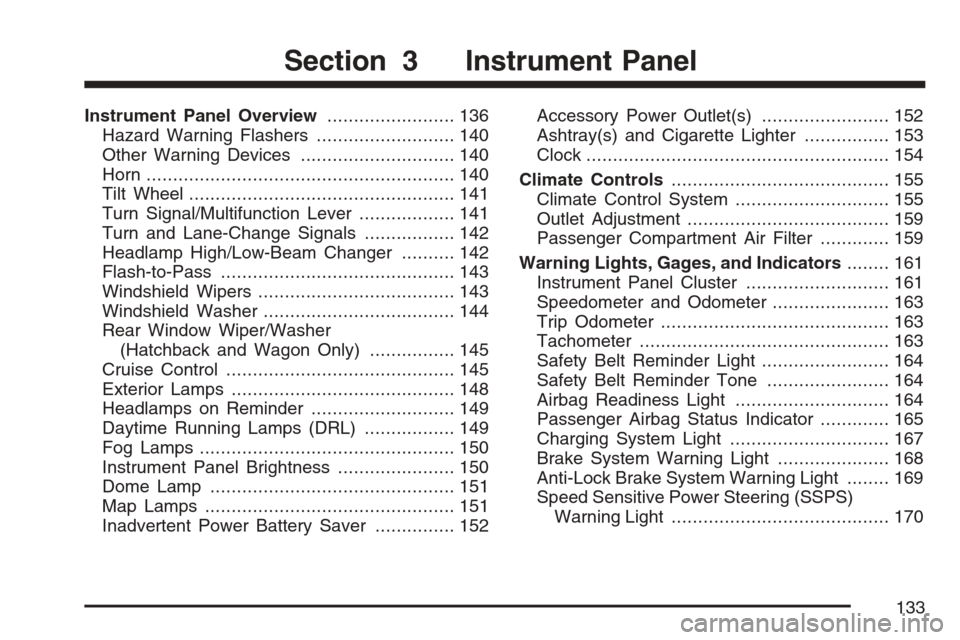
Instrument Panel Overview........................ 136
Hazard Warning Flashers.......................... 140
Other Warning Devices............................. 140
Horn.......................................................... 140
Tilt Wheel.................................................. 141
Turn Signal/Multifunction Lever.................. 141
Turn and Lane-Change Signals................. 142
Headlamp High/Low-Beam Changer.......... 142
Flash-to-Pass............................................ 143
Windshield Wipers..................................... 143
Windshield Washer.................................... 144
Rear Window Wiper/Washer
(Hatchback and Wagon Only)................ 145
Cruise Control........................................... 145
Exterior Lamps.......................................... 148
Headlamps on Reminder........................... 149
Daytime Running Lamps (DRL)................. 149
Fog Lamps................................................ 150
Instrument Panel Brightness...................... 150
Dome Lamp.............................................. 151
Map Lamps............................................... 151
Inadvertent Power Battery Saver............... 152Accessory Power Outlet(s)........................ 152
Ashtray(s) and Cigarette Lighter................ 153
Clock......................................................... 154
Climate Controls......................................... 155
Climate Control System............................. 155
Outlet Adjustment...................................... 159
Passenger Compartment Air Filter............. 159
Warning Lights, Gages, and Indicators........ 161
Instrument Panel Cluster........................... 161
Speedometer and Odometer...................... 163
Trip Odometer........................................... 163
Tachometer............................................... 163
Safety Belt Reminder Light........................ 164
Safety Belt Reminder Tone....................... 164
Airbag Readiness Light............................. 164
Passenger Airbag Status Indicator............. 165
Charging System Light.............................. 167
Brake System Warning Light..................... 168
Anti-Lock Brake System Warning Light........ 169
Speed Sensitive Power Steering (SSPS)
Warning Light......................................... 170
Section 3 Instrument Panel
133
Page 170 of 422

Speed Sensitive Power
Steering (SSPS) Warning Light
If your vehicle has
Speed Sensitive Power
Steering, this warning
light will come on briefly
when you turn the
ignition to ON as a check
to show you it is working.
Then it should go out after a few seconds.
If the warning light does not come on, have it fixed
so it will be able to warn you if there is a problem.
If the warning light stays on, or comes on while
you are driving, the system may not be working.
If this happens, see your dealer for service.
Hold Mode Light
If your vehicle has this
feature, this light will
come on when the hold
mode is active.
If the HOLD mode light flashes, have your vehicle
checked. See “Hold Mode” underAutomatic
Transaxle Operation on page 110for additional
information on this feature.
170
Page 202 of 422

Audio Steering Wheel Controls
If your vehicle has this feature, some audio
controls can be adjusted at the steering wheel.
They include the following:
PWR (Power):Press this button to turn the audio
system on or off.
Press and hold this button for less than
two seconds to silence the system. Press and
release this button again to turn the sound back on.SEEK:Press and release this button within
0.5 seconds to go to the next preset station.
Press and hold this button for longer than
0.5 seconds to go to the next radio station.
The radio seeks stations only with a strong signal
that are in the selected band.
When playing a CD, press and release this button
within 0.5 seconds to go to the next track. Press
and hold this button for longer than 0.5 seconds to
fast forward through the tracks.
MODE:Press and release this button to select
FM1, FM2, FM-A, AM1, AM2, AM-A, or CD (MP3).
Press and release this button multiple times to
cycle through the audio playback options that are
available on your vehicle.
+ VOLUME−:Press the toggle bar located below
the + VOLUME−to adjust the volume. Press
the left side of the toggle bar, below the + (plus)
sign to increase the volume. Press the right side of
the toggle bar, below the−(minus) sign to
decrease the volume.
Front View of the
Steering Wheel ControlsSide View of the Volume
Control
202
Page 214 of 422
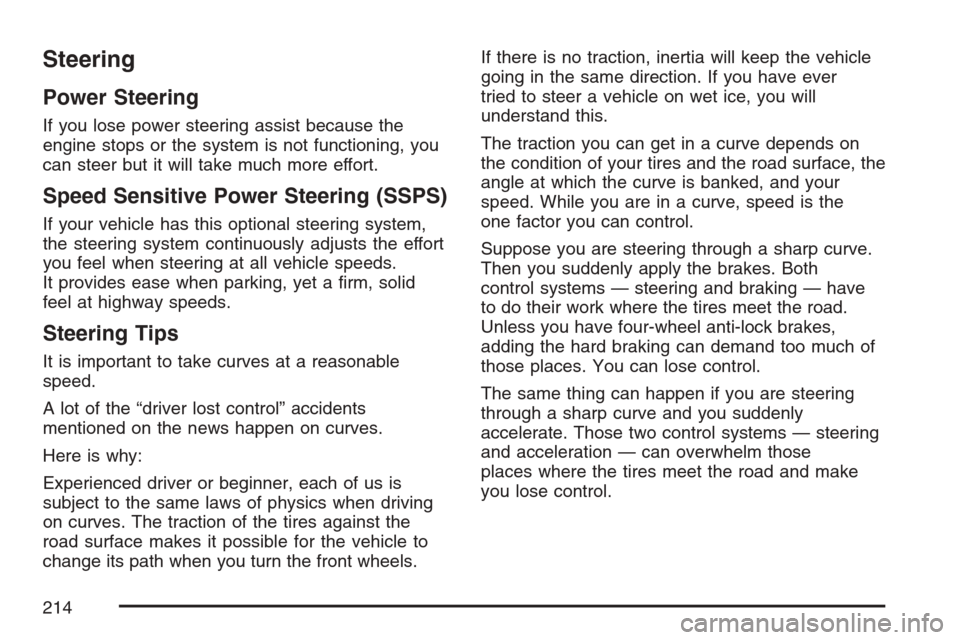
Steering
Power Steering
If you lose power steering assist because the
engine stops or the system is not functioning, you
can steer but it will take much more effort.
Speed Sensitive Power Steering (SSPS)
If your vehicle has this optional steering system,
the steering system continuously adjusts the effort
you feel when steering at all vehicle speeds.
It provides ease when parking, yet a firm, solid
feel at highway speeds.
Steering Tips
It is important to take curves at a reasonable
speed.
A lot of the “driver lost control” accidents
mentioned on the news happen on curves.
Here is why:
Experienced driver or beginner, each of us is
subject to the same laws of physics when driving
on curves. The traction of the tires against the
road surface makes it possible for the vehicle to
change its path when you turn the front wheels.If there is no traction, inertia will keep the vehicle
going in the same direction. If you have ever
tried to steer a vehicle on wet ice, you will
understand this.
The traction you can get in a curve depends on
the condition of your tires and the road surface, the
angle at which the curve is banked, and your
speed. While you are in a curve, speed is the
one factor you can control.
Suppose you are steering through a sharp curve.
Then you suddenly apply the brakes. Both
control systems — steering and braking — have
to do their work where the tires meet the road.
Unless you have four-wheel anti-lock brakes,
adding the hard braking can demand too much of
those places. You can lose control.
The same thing can happen if you are steering
through a sharp curve and you suddenly
accelerate. Those two control systems — steering
and acceleration — can overwhelm those
places where the tires meet the road and make
you lose control.
214
Page 245 of 422
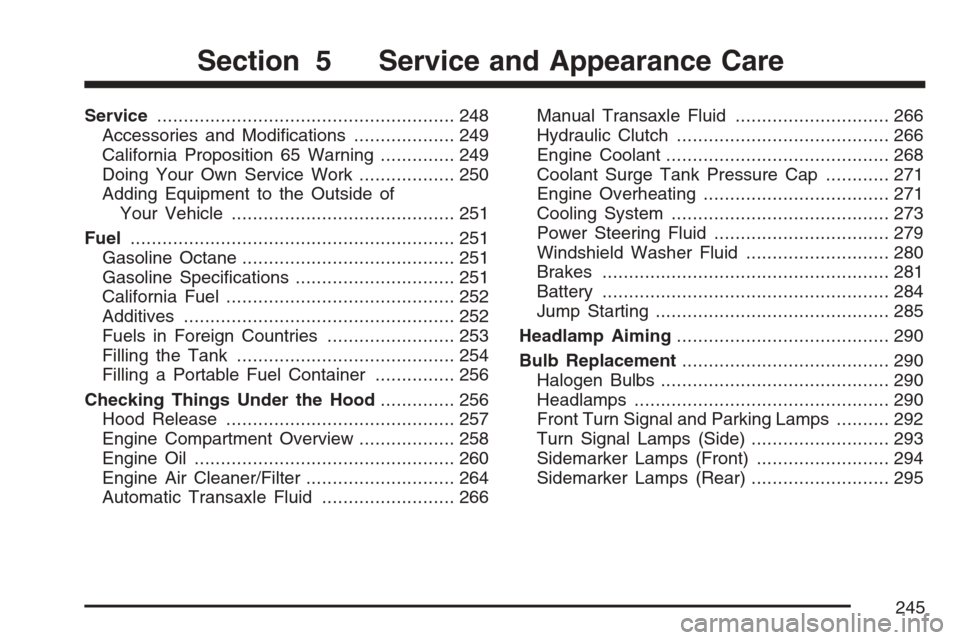
Service........................................................ 248
Accessories and Modifications................... 249
California Proposition 65 Warning.............. 249
Doing Your Own Service Work.................. 250
Adding Equipment to the Outside of
Your Vehicle.......................................... 251
Fuel............................................................. 251
Gasoline Octane........................................ 251
Gasoline Specifications.............................. 251
California Fuel........................................... 252
Additives................................................... 252
Fuels in Foreign Countries........................ 253
Filling the Tank......................................... 254
Filling a Portable Fuel Container............... 256
Checking Things Under the Hood.............. 256
Hood Release........................................... 257
Engine Compartment Overview.................. 258
Engine Oil................................................. 260
Engine Air Cleaner/Filter............................ 264
Automatic Transaxle Fluid......................... 266Manual Transaxle Fluid............................. 266
Hydraulic Clutch........................................ 266
Engine Coolant.......................................... 268
Coolant Surge Tank Pressure Cap............ 271
Engine Overheating................................... 271
Cooling System......................................... 273
Power Steering Fluid ................................. 279
Windshield Washer Fluid........................... 280
Brakes...................................................... 281
Battery...................................................... 284
Jump Starting............................................ 285
Headlamp Aiming........................................ 290
Bulb Replacement....................................... 290
Halogen Bulbs........................................... 290
Headlamps................................................ 290
Front Turn Signal and Parking Lamps.......... 292
Turn Signal Lamps (Side).......................... 293
Sidemarker Lamps (Front)......................... 294
Sidemarker Lamps (Rear).......................... 295
Section 5 Service and Appearance Care
245
Page 259 of 422
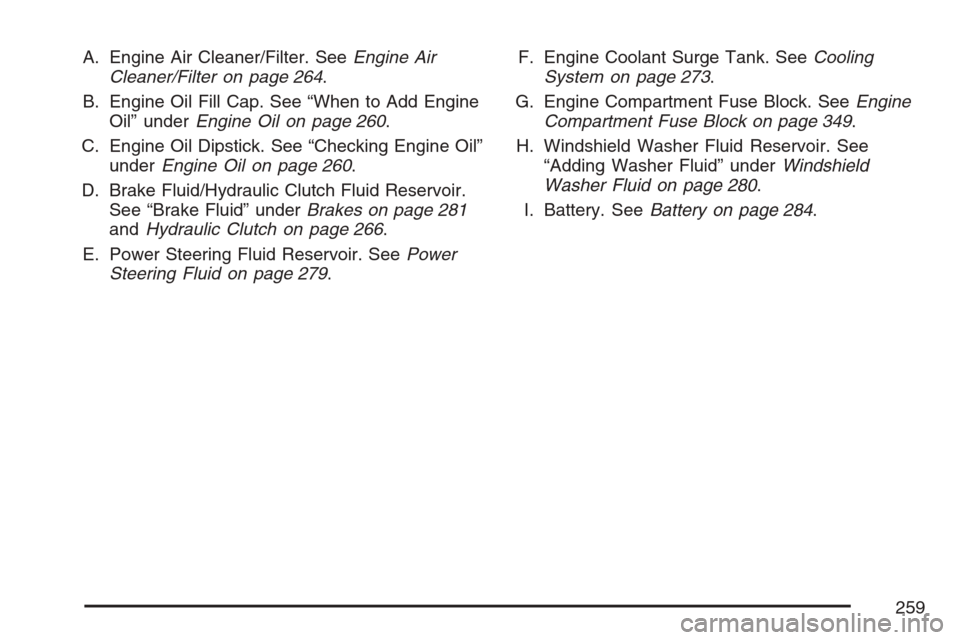
A. Engine Air Cleaner/Filter. SeeEngine Air
Cleaner/Filter on page 264.
B. Engine Oil Fill Cap. See “When to Add Engine
Oil” underEngine Oil on page 260.
C. Engine Oil Dipstick. See “Checking Engine Oil”
underEngine Oil on page 260.
D. Brake Fluid/Hydraulic Clutch Fluid Reservoir.
See “Brake Fluid” underBrakes on page 281
andHydraulic Clutch on page 266.
E. Power Steering Fluid Reservoir. SeePower
Steering Fluid on page 279.F. Engine Coolant Surge Tank. SeeCooling
System on page 273.
G. Engine Compartment Fuse Block. SeeEngine
Compartment Fuse Block on page 349.
H. Windshield Washer Fluid Reservoir. See
“Adding Washer Fluid” underWindshield
Washer Fluid on page 280.
I. Battery. SeeBattery on page 284.
259
Page 279 of 422
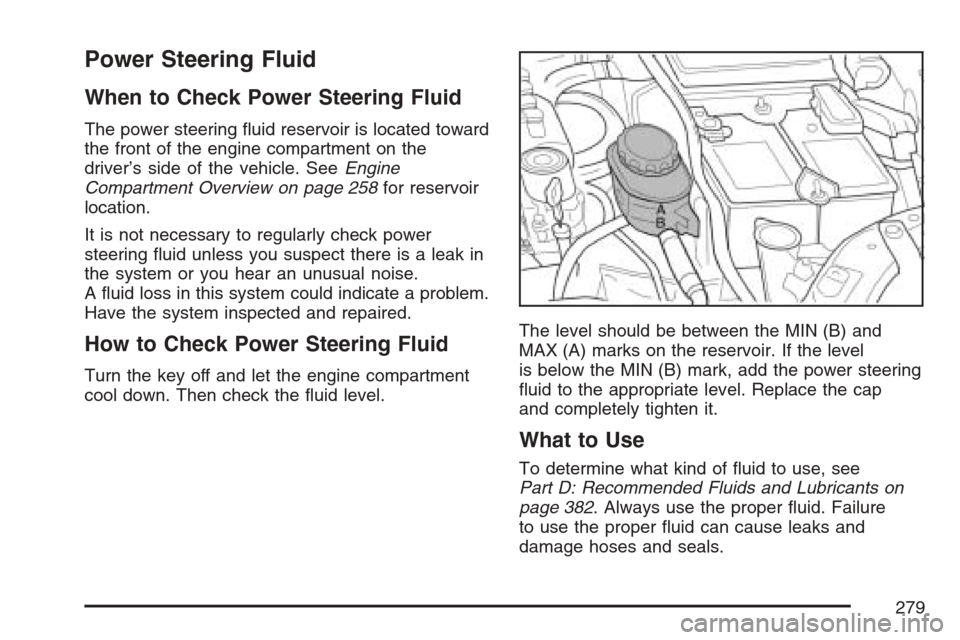
Power Steering Fluid
When to Check Power Steering Fluid
The power steering fluid reservoir is located toward
the front of the engine compartment on the
driver’s side of the vehicle. SeeEngine
Compartment Overview on page 258for reservoir
location.
It is not necessary to regularly check power
steering fluid unless you suspect there is a leak in
the system or you hear an unusual noise.
A fluid loss in this system could indicate a problem.
Have the system inspected and repaired.
How to Check Power Steering Fluid
Turn the key off and let the engine compartment
cool down. Then check the fluid level.The level should be between the MIN (B) and
MAX (A) marks on the reservoir. If the level
is below the MIN (B) mark, add the power steering
fluid to the appropriate level. Replace the cap
and completely tighten it.
What to Use
To determine what kind of fluid to use, see
Part D: Recommended Fluids and Lubricants on
page 382. Always use the proper fluid. Failure
to use the proper fluid can cause leaks and
damage hoses and seals.
279
Page 307 of 422
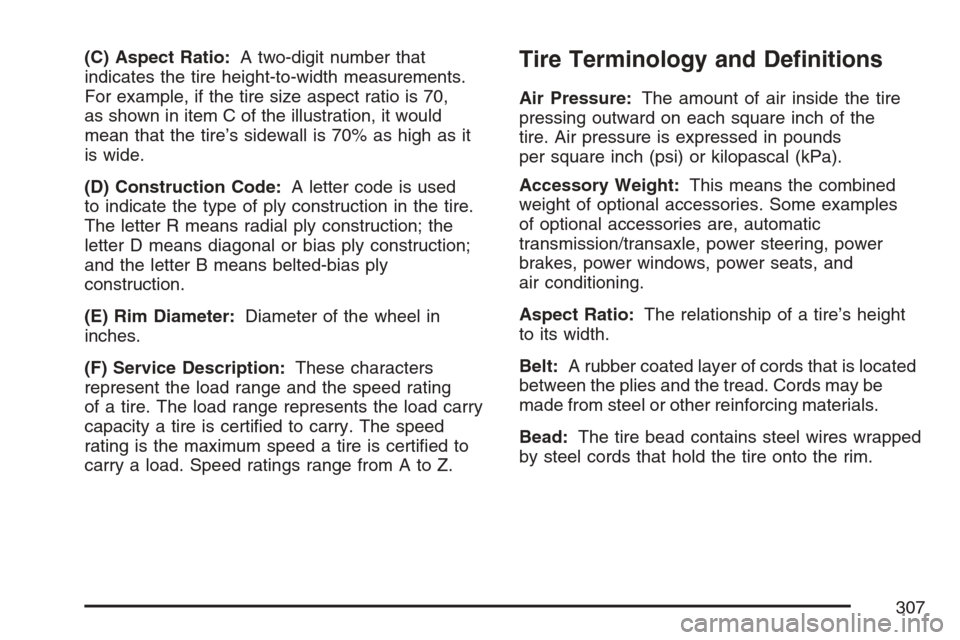
(C) Aspect Ratio:A two-digit number that
indicates the tire height-to-width measurements.
For example, if the tire size aspect ratio is 70,
as shown in item C of the illustration, it would
mean that the tire’s sidewall is 70% as high as it
is wide.
(D) Construction Code:A letter code is used
to indicate the type of ply construction in the tire.
The letter R means radial ply construction; the
letter D means diagonal or bias ply construction;
and the letter B means belted-bias ply
construction.
(E) Rim Diameter:Diameter of the wheel in
inches.
(F) Service Description:These characters
represent the load range and the speed rating
of a tire. The load range represents the load carry
capacity a tire is certified to carry. The speed
rating is the maximum speed a tire is certified to
carry a load. Speed ratings range from A to Z.Tire Terminology and De�nitions
Air Pressure:The amount of air inside the tire
pressing outward on each square inch of the
tire. Air pressure is expressed in pounds
per square inch (psi) or kilopascal (kPa).
Accessory Weight:This means the combined
weight of optional accessories. Some examples
of optional accessories are, automatic
transmission/transaxle, power steering, power
brakes, power windows, power seats, and
air conditioning.
Aspect Ratio:The relationship of a tire’s height
to its width.
Belt:A rubber coated layer of cords that is located
between the plies and the tread. Cords may be
made from steel or other reinforcing materials.
Bead:The tire bead contains steel wires wrapped
by steel cords that hold the tire onto the rim.
307
Page 380 of 422
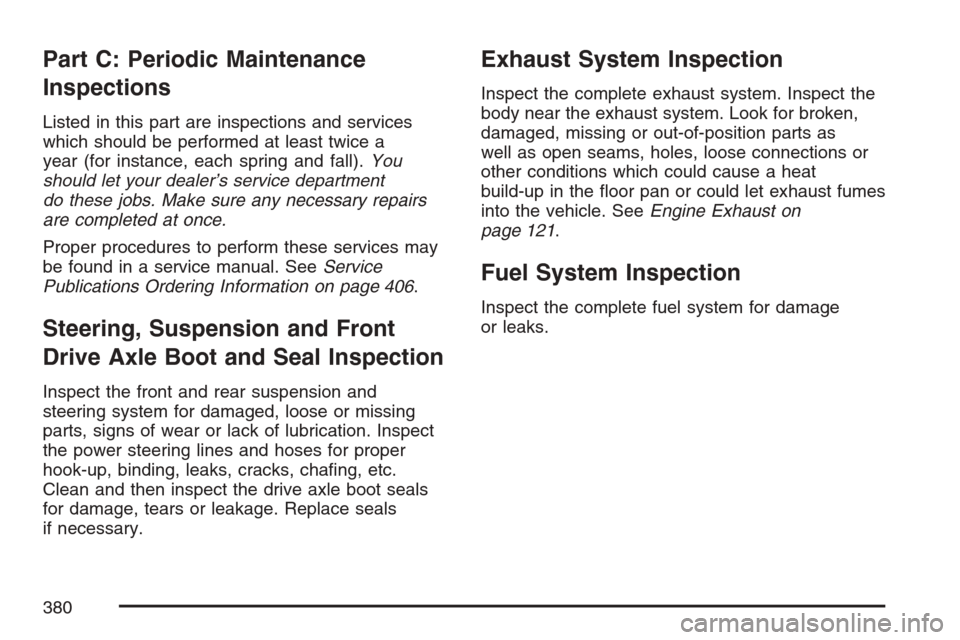
Part C: Periodic Maintenance
Inspections
Listed in this part are inspections and services
which should be performed at least twice a
year (for instance, each spring and fall).You
should let your dealer’s service department
do these jobs. Make sure any necessary repairs
are completed at once.
Proper procedures to perform these services may
be found in a service manual. SeeService
Publications Ordering Information on page 406.
Steering, Suspension and Front
Drive Axle Boot and Seal Inspection
Inspect the front and rear suspension and
steering system for damaged, loose or missing
parts, signs of wear or lack of lubrication. Inspect
the power steering lines and hoses for proper
hook-up, binding, leaks, cracks, chafing, etc.
Clean and then inspect the drive axle boot seals
for damage, tears or leakage. Replace seals
if necessary.
Exhaust System Inspection
Inspect the complete exhaust system. Inspect the
body near the exhaust system. Look for broken,
damaged, missing or out-of-position parts as
well as open seams, holes, loose connections or
other conditions which could cause a heat
build-up in the floor pan or could let exhaust fumes
into the vehicle. SeeEngine Exhaust on
page 121.
Fuel System Inspection
Inspect the complete fuel system for damage
or leaks.
380
Page 382 of 422
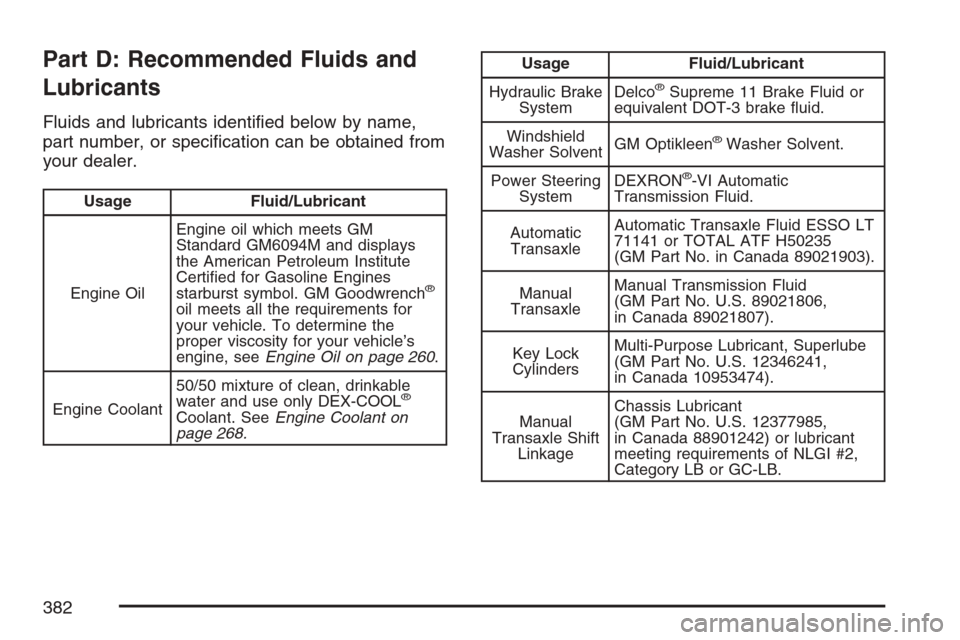
Part D: Recommended Fluids and
Lubricants
Fluids and lubricants identified below by name,
part number, or specification can be obtained from
your dealer.
Usage Fluid/Lubricant
Engine OilEngine oil which meets GM
Standard GM6094M and displays
the American Petroleum Institute
Certified for Gasoline Engines
starburst symbol. GM Goodwrench
®
oil meets all the requirements for
your vehicle. To determine the
proper viscosity for your vehicle’s
engine, seeEngine Oil on page 260.
Engine Coolant50/50 mixture of clean, drinkable
water and use only DEX-COOL
®
Coolant. SeeEngine Coolant on
page 268.
Usage Fluid/Lubricant
Hydraulic Brake
SystemDelco
®Supreme 11 Brake Fluid or
equivalent DOT-3 brake fluid.
Windshield
Washer SolventGM Optikleen
®Washer Solvent.
Power Steering
SystemDEXRON
®-VI Automatic
Transmission Fluid.
Automatic
TransaxleAutomatic Transaxle Fluid ESSO LT
71141 or TOTAL ATF H50235
(GM Part No. in Canada 89021903).
Manual
TransaxleManual Transmission Fluid
(GM Part No. U.S. 89021806,
in Canada 89021807).
Key Lock
CylindersMulti-Purpose Lubricant, Superlube
(GM Part No. U.S. 12346241,
in Canada 10953474).
Manual
Transaxle Shift
LinkageChassis Lubricant
(GM Part No. U.S. 12377985,
in Canada 88901242) or lubricant
meeting requirements of NLGI #2,
Category LB or GC-LB.
382